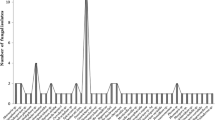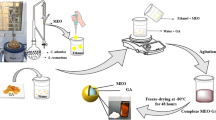Abstract
Incubation with microbial culture supernatants improved essential oil yield from Aquilaria subintegra woodchips. The harvested woodchips were incubated with de man, rogosa and sharpe (MRS) agar, yeast mold (YM) agar medium and six different microbial culture supernatants obtained from Lactobacillus bulgaricus, L. acidophilus, Streptococcus thermophilus, Lactococcus lactis, Saccharomyces carlsbergensis and S. cerevisiae prior to hydrodistillation. Incubation with lactic acid bacteria supernatants provided higher yield of agarwood oil (0.45% w/w) than that obtained from yeast (0.25% w/w), agar media (0.23% w/w) and water (0.22% w/w). The composition of agarwood oil from all media and microbial supernatant incubations was investigated by using gas chromatography-mass spectrometry. Overall, three major volatile profiles were obtained, which corresponded to water soaking (control), as well as, both YM and MRS media, lactic acid bacteria, and yeast supernatant incubations. Sesquiterpenes and their oxygenated derivatives were key components of agarwood oil. Fifty-two volatile components were tentatively identified in all samples. Beta-agarofuran, α-eudesmol, karanone, α-agarofuran and agarospirol were major components present in most of the incubated samples, while S. cerevisiae-incubated A. subintegra provided higher amount of phenyl acetaldehyde. Microbial culture supernatant incubation numerically provided the highest yield of agarwood oil compared to water soaking traditional method, possibly resulting from activity of extracellular enzymes produced by the microbes. Incubation of agarwood with lactic acid bacteria supernatant significantly enhanced oil yields without changing volatile profile/composition of agarwood essential oil, thus this is a promising method for future use.

Similar content being viewed by others
References
Yoswathana N (2013) Extraction of agarwood (Aquilaria crassna) oil by using supercritical carbon dioxide extraction and enzyme pretreatment on hydrodistillation. Food Agric Environ 11:1055–1059
Hashim YZHY, Ismail NI, Abbas P (2014) Analysis of chemical compounds of agarwood oil from different species by gas chromatography mass spectrometry (GCMS). IIUM Eng J 15:55–60
Okudera Y, Ito M (2009) Production of agarwood fragrant constituents in Aquilaria calli and cell suspension cultures. Plant Biotechnol 26:307–315. https://doi.org/10.5511/plantbiotechnology.26.307
Monggoot S, Popluechai S, Gentekaki E, Pripdeevech P (2017) Fungal endophytes: an alternative source for production of volatile compounds from agarwood oil of Aquilaria subintegra. Microb Ecol 74:54–61. https://doi.org/10.1007/s00248-016-0908-4
Jok VA, Radzi NC, Hamid KHK (2014) Effect of soaking on the temperature and pH profiles in agarwood extraction. IJLRST 3:111–113
Longo MA, Sanromán MA (2006) Production of food aroma compounds: microbial and enzymatic methodologies. Food Technol Biotechnol 44:335–353
Welsh FW, Murray WD, Williams RE, Katz I (1989) Microbiological and enzymatic production of flavor and fragrance chemicals. Crit Rev Biotechnol 9:105–169
Leejeerajumnean A, Duckham SC, Owens JD, Ames JM (2001) Volatile compounds in bacillus-fermented soybeans. J Sci Food Agric 81:525–529
Ouoba LII, Diawara B, Annan NT, Poll L, Jakobsen M (2005) Volatile compounds of Soumbala, a fermented African locust bean (Parkia biglobosa) food condiment. J Appl Microbiol 99:1413–1421
Krings U, Berger RG (1998) Biotechnological production of flavors and fragrances. Appl Microbiol Biotechnol 49:1–8
Vandamme EJ, Soetaert W (2002) Bioflavours and fragrances via fermentation and biocatalysis. J Chem Technol Biotechnol 77:1323–1332. https://doi.org/10.1002/jctb.722
Aguedo M, Ly MH, Belo I, Teixeira JA, Belin JM, Waché Y (2004) The use of enzymes and microorganisms for the production of aroma compounds from lipids. Food Technol Biotechnol 42:327–336
Palmeri R, Spagna G (2007) β-Glucosidase in cellular and acellular form for winemaking application. Enzym Microb Technol 40:382–389
Fr B, Griebe T, Nielsen PH (1995) Enzymatic activity in the activated-sludge floc matrix. Appl Microbiol Biotechnol 43:755–761
Rathnam CKM, Edwards GE (1975) Intracellular localization of certain photosynthetic enzymes in bundle sheath cells of plants possessing the C4 pathway of photosynthesis. Arch Biochem Biophys 171:14–225
Saifuddin N, Wong CW, Yasumira AA (2009) Rapid biosynthesis of silver nanoparticles using culture supernatant of bacteria with microwave irradiation. J Chem 6:61–70
Volesky B, Luong JH, Aunstrup K (1984) Microbial enzymes: production, purification, and isolation. Crit Rev Biotechnol 2:119–146
Cui Y, Chatterjee A, Liu Y, Dumenyo CK, Chatterjee AK (1995) Identification of a global repressor gene, rsmA, of Erwinia carotovora subsp. carotovora that controls extracellular enzymes, N-(3-oxohexanoyl)-l-homoserine lactone, and pathogenicity in soft-rotting Erwinia spp. J Bacteriol 177:5108–5115
Sánchez-Porro C, Martin S, Mellado E, Ventosa A (2003) Diversity of moderately halophilic bacteria producing extracellular hydrolytic enzymes. J Appl Microbiol 94:295–300
Men L, Wang Y (2007) The oxidation of yeast alcohol dehydrogenase-1 by hydrogen peroxide in vitro. J Proteome Res 6:216–225. https://doi.org/10.1021/pr0603809
Ishihara M, Tsuneya T (1993) Components of the agarwood smoke on heating. J Essent Oil Res 6:120–123
Näf R, Velluz A, Brauchli R, Thommen W (1995) Agarwood oil (Aquilaria agallocha Roxb.). Its composition and eight new valencane-, eremophilane- and vetispirane-derivatives. Flavour Fragr J 10:147–152. https://doi.org/10.1002/ffj.2730100306
Meier M, Kohlenberg B, Braun NA (2003) Isolation of anisyl acetone from agarwood oil. J Essent Oil Res 8:340–345. https://doi.org/10.1080/10412905.2003.9712266
Ito M, Okimoto K, Yagura T, Hinda G, Kiuchi F, Shimada Y (2005) Induction of sesquiterpenoid production by methyl jasmonate in Aquilaria sinensis cell suspension culture. J Essent Oil Res 17:175–180. https://doi.org/10.1080/10412905.2005.9698867
Pripdeevech P, Khummueng W, Park SK (2011) Identification of odor-active components of agarwood essential oils from Thailand by solid phase microextraction-GC/MS and GC-O. J Essent Oil Res 23:46–53
Naidu AS, Bidlack WR, Clemens RA (1999) Probiotic spectra of lactic acid bacteria (LAB). Crit Rev Food Sci Nutr 38:13–126. https://doi.org/10.1080/10408699991279187
Adams RP (2007) Identification of essential oil components by gas chromatograph/mass spectrometry, 4th edn. Allured Publishing Corporation, Carol Stream
Babushok VI, Linstrom PJ, Zenkevich IG (2011) Retention indices for frequently reported compounds of plant essential oils. J Phys Chem Ref Data 40:1–47. https://doi.org/10.1063/1.3653552
Acknowledgements
The authors gratefully acknowledge support provided by the Mae Fah Luang University for funding. We are grateful to personnel of the Queen Sirikit Botanical Garden for their help in collection and identification of A. subintegra plants and the Scientific and Technological Instrument Centre of Mae Fah Luang University for their instrumental support concerning the GC–MS.
Author information
Authors and Affiliations
Corresponding author
Rights and permissions
About this article
Cite this article
Monggoot, S., Kulsing, C., Wong, Y.F. et al. Incubation of Aquilaria subintegra with Microbial Culture Supernatants Enhances Production of Volatile Compounds and Improves Quality of Agarwood Oil. Indian J Microbiol 58, 201–207 (2018). https://doi.org/10.1007/s12088-018-0717-1
Received:
Accepted:
Published:
Issue Date:
DOI: https://doi.org/10.1007/s12088-018-0717-1




